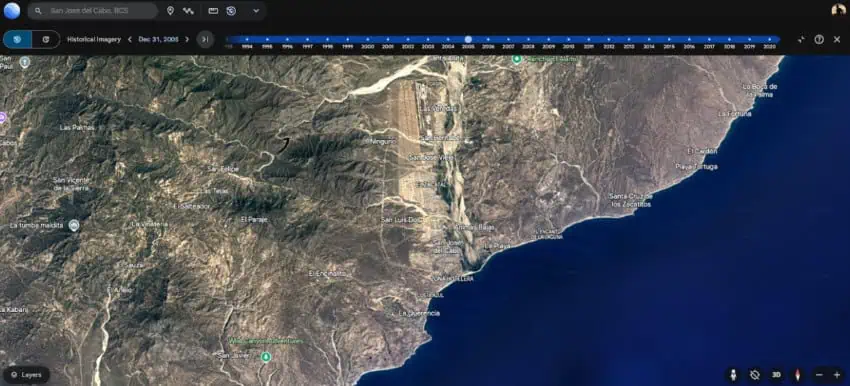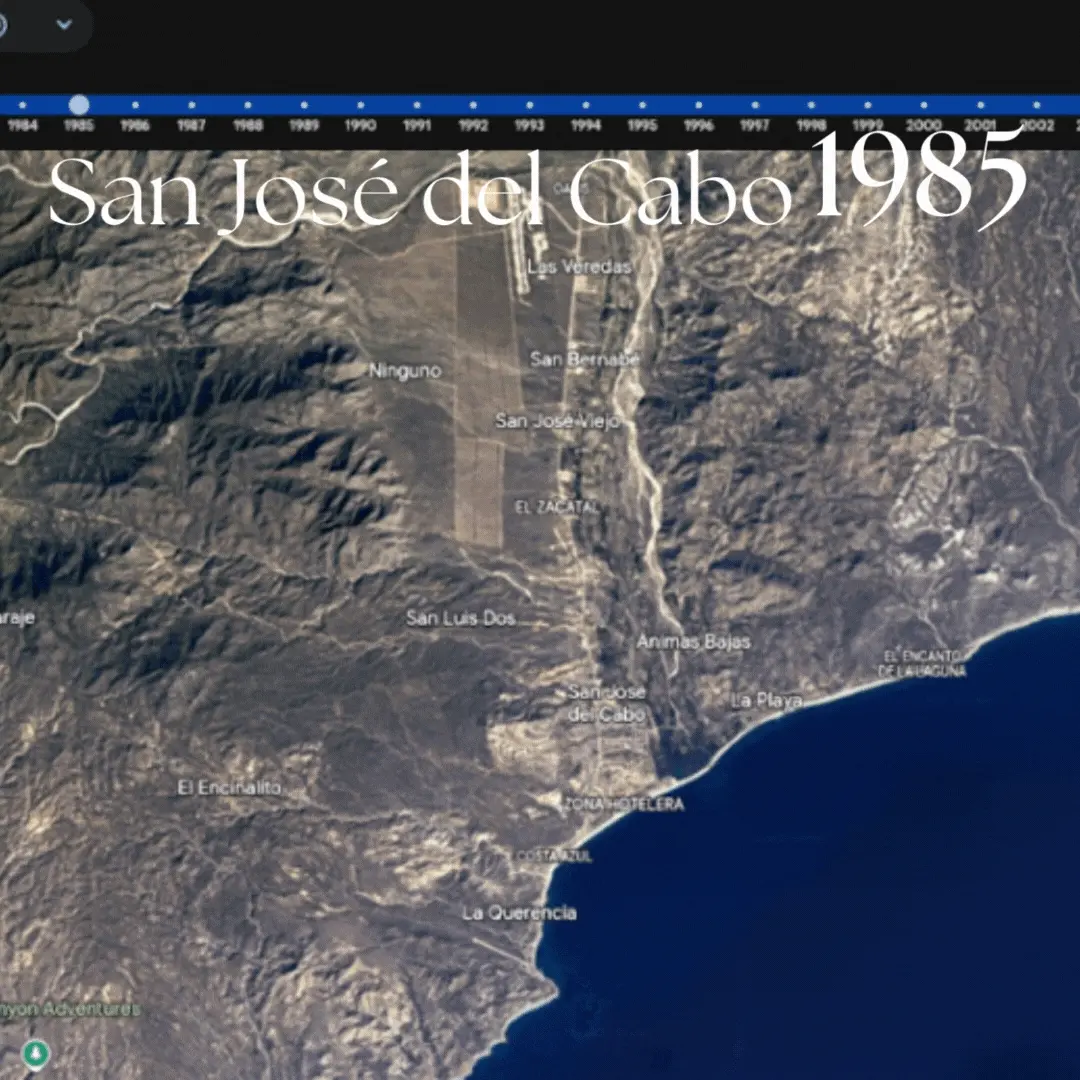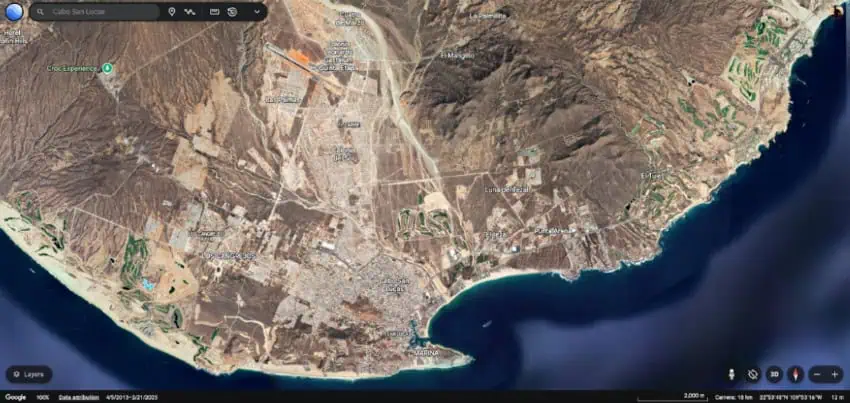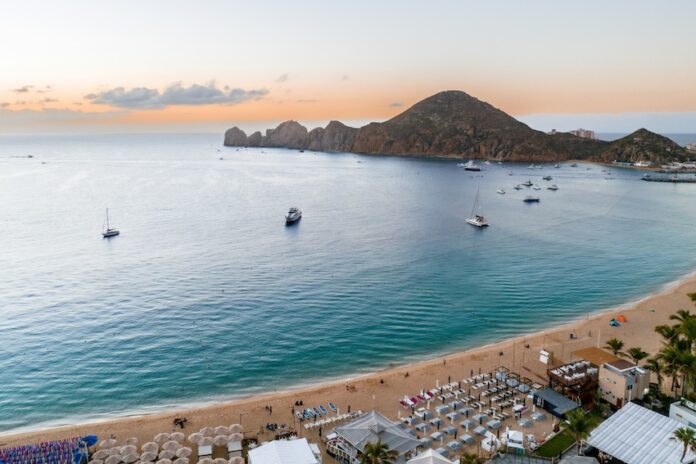For those who’ve visited Los Cabos or lived in the area for any appreciable amount of time, the changes that have occurred here in recent decades are remarkable, not only in terms of population increases or the rapid rise in the number of tourists visiting but also in terms of general development.
For this article, I used Google Earth imagery to show how the maps of cape cities Cabo San Lucas and San José del Cabo have changed since 1985 (the limits of Google Earth’s historical capacity). I’ve paid particular attention to the timeframe 2005 – 2025, not only because Google Earth’s satellite imagery quality improves from this point onwards, but also because this is when the pace of development quickens.
Cabo San Lucas and San José del Cabo in 1985

One of the first things you’ll notice in these maps is that they show no golf courses. That’s because there were none before 1987. Nor were there many hotels since tourism was not very developed. The Hotel Twin Dolphin, a Tourist Corridor favorite of the time, had 55 rooms, according to my Baja Traveler guidebook published in 1988. The Hotel Finisterra in Cabo San Lucas had the same number. Meanwhile, in San José del Cabo, the Hotel El Presidente boasted 250 rooms, a massive number for the time.
By 1990, the closest year I could find accurate data, there were 22 hotels with 2,531 rooms in Los Cabos serving the 228,000 foreign tourists who visited that year. The population, likewise, remained very modest by today’s standards. The Los Cabos municipality had 43,920 residents as of the 1990 census, with Cabo San Lucas and San José del Cabo each boasting around 15,000 residents.
Nightlife started in earnest in 1989 and 1990 in Cabo San Lucas, with El Squid Roe, Cabo Wabo, and Giggling Marlin appearing around this time.
Cabo San Lucas and San José del Cabo in 2005

By the dawn of the new century, growth is rapid in both Cabo San Lucas and San José del Cabo. The combined population in the Los Cabos municipality rose from 105,469 in 2000 to 164,162 in 2005 to 238,487 in 2010.
The Los Cangrejos and Colonia del Sol neighborhoods rapidly grew in Cabo San Lucas. Indeed, according to the book Los Cabos, Prospective for a Natural and Tourism Paradise, 99% of the growth in Los Cabos between 2000 and 2005 occurred in just a few places: Cabo San Lucas and its Colonia del Sol and Los Cangrejos neighborhoods; and in San José del Cabo colonias like San José Viejo, San Bernabé, Las Veredas, and La Playa.
There were still no golf courses evident on the Pacific Coast. Davis Love III’s acclaimed Diamante Dunes Course would be the first in 2009. However, several can be seen in the Tourist Corridor, including the Cabo San Lucas Country Club and the Ocean and Desert courses at Cabo del Sol.
San José del Cabo experienced 124% growth during this decade, as the population of residents grew from 31,102 in 2000 to 69,788 in 2010. Golf courses, the backbone of local real estate developments, have been built at Querencia (2000), but not yet at Club Campestre or Puerto Los Cabos (both 2007).
Even bigger gains were being made in terms of tourism. Foreign tourists rose from 464,200 in 2000 to 842,606 in 2010. As tourism numbers climbed, the hotel room inventory in Los Cabos more than doubled, increasing from 6,167 in 2000 to 13,390 in 2010.
Cabo San Lucas and San José del Cabo in 2015

The Category 4 Hurricane Odile, which hit Los Cabos on September 14th, 2014, did over one billion dollars worth of damage, but didn’t slow down growth, as these 2015 satellite photos indicate. El Tezal, Cabo Bello, and Cangrejos are all growing in Cabo San Lucas, with several golf courses now evident on the Pacific Coast of the Land’s End city, including Love’s Dunes Course, Tiger Woods’ El Cardonal (2014) at Diamante, and Jack Nicklaus’ Quivira (2014).
There were 118 hotels in Los Cabos in 2013, although the number of rooms had declined slightly to only 13,003 in 2014. The total population of Los Cabos in 2014 was 294,452, with both Cabo San Lucas (99,072) and San José del Cabo (95,310) poised to break 100,000 and transform from towns to cities.
The RIU Santa Fe, with 1,200 rooms in Cabo San Lucas, became the largest hotel in the area during this era. Hotels and resorts like The Cape, A Thompson Hotel in the Tourist Corridor, and the Hyatt Ziva and JW Marriott in San José del Cabo welcomed guests for the first time in 2015. The Hyatt Ziva, featuring 591 rooms, joined RIU Santa Fe and the RIU Palaces among Los Cabos’ biggest properties.
Cabo San Lucas and San José del Cabo in 2025

By 2025, Baja California Sur had 500 hotels and 29,000 hotel rooms available, with the largest part of the inventory (over 180 hotels and 18,000 rooms) in Los Cabos. Close to four million tourists visited in 2023 and 2024, with the population at 351,111 as of the 2020 census. Los Cabos had surpassed La Paz in terms of population, with Cabo San Lucas boasting 202,694 residents, and San José del Cabo at 136,285.
Using the Google Earth distance tool, I measured the developed area in Cabo San Lucas in 1985 at its outermost points as about 2.5 kilometers in length by 1.25 kilometers in width. By 2025, it had expanded to about 11 x 7. Thus, the physical dimensions of the city were growing. The same is true for San José del Cabo, although less dramatically so visually.
However, despite what seems to be fluid borders of the cape cities, the area of the Los Cabos municipality has remained stable, leading to a population density that has continued to rise. It was 93.6 residents per square kilometer in 2020, up from 11.7 in 1990, 28.1 in 2000, 63.6 in 2010, and 76.7 in 2015. The current number is the highest in Baja California Sur, although it bears noting that the state overall has the lowest population density in Mexico.
Chris Sands is the Cabo San Lucas local expert for the USA Today travel website 10 Best, writer of Fodor’s Los Cabos travel guidebook and a contributor to numerous websites and publications, including Tasting Table, Marriott Bonvoy Traveler, Forbes Travel Guide, Porthole Cruise, Cabo Living and Mexico News Daily. His specialty is travel-related content and lifestyle features focused on food, wine and golf.
